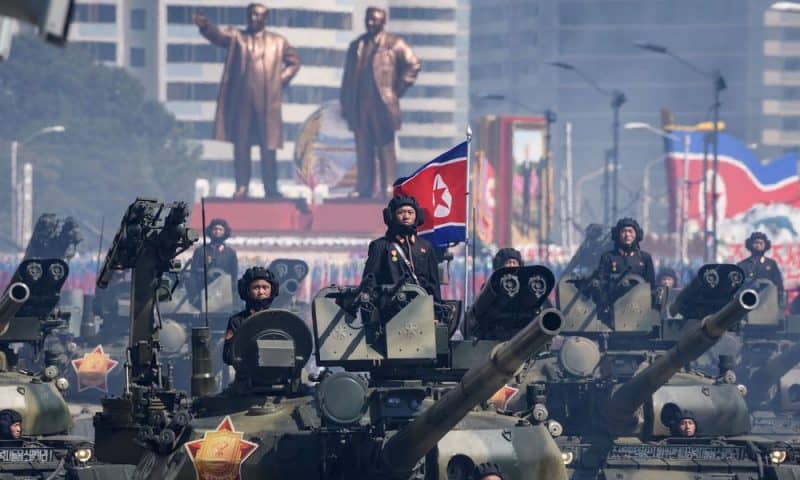In an unusual deployment, the Navy has sent three of its 11 nuclear aircraft carriers to the Pacific in an apparent response to Chinese aggression.
THE NAVY FOR THE FIRST time in years has deployed three aircraft carrier strike groups to operate in the Pacific simultaneously in what’s being seen as a powerful signal to China of U.S. resilience amid reports that Beijing is exploiting the spread of the coronavirus to advance its foreign policy goals.
The USS Theodore Roosevelt, newly back at sea after having been sidelined by the spread of COVID-19, is now patrolling around Guam in the Philippine Sea. The USS Nimitz, one of the first ships to set sail after new protocols were put in place to stem another outbreak of the virus, is off the West Coast of the U.S. And the USS Ronald Reagan is also in the Philippine Sea south of Japan, where it recently left port.
The highly unusual posturing comes as U.S. officials in recent weeks have expressed concern that China is capitalizing on the fallout from the pandemic to claim contested or international territory as its own at a time it believes the U.S. military is not prepared to respond.
China on Monday fired back at the deployment, which it says has not happened since 2017.
“They seem to worry that the outside world is doubting their military capability,” Zhang Junshe, a research fellow for China’s Military Studies Research Institute, told the state news outlet Global Times in an article Monday under the headline, “U.S. Navy’s deployment of 3 aircraft carriers to Pacific a mere show of vanity.”
“Therefore,” Zhang added, “the U.S. Navy decided to send its carrier strike groups to flex muscles in the West Pacific region, exhibiting to other countries that their combat capability was ultimately not hindered by the novel coronavirus pandemic.”
The Navy did not immediately respond to requests for comment.
State Department spokeswoman Morgan Ortagus issued a statement in April blasting the Chinese navy for sinking a Vietnamese fishing vessel in the South China Sea, calling it “the latest in a long string of PRC actions to assert unlawful maritime claims.”
“Since the outbreak of the global pandemic, Beijing has also announced new ‘research stations’ on military bases it built on Fiery Cross Reef and Subi Reef, and landed special military aircraft on Fiery Cross Reef,” Ortagus said, adding that China had also deployed militia forces around the Spratly Islands.
“We call on the PRC to remain focused on supporting international efforts to combat the global pandemic, and to stop exploiting the distraction or vulnerability of other states to expand its unlawful claims in the South China Sea,” she said.
But Beijing’s propaganda has portrayed the effect of the coronavirus as devastating to the U.S. Navy.
“The U.S. is attempting to demonstrate to the whole region and even the world that it remains the most powerful naval force,” Chinese state media wrote in an article published Sunday, citing a local military expert.
So it also appears likely that the U.S. to at least some degree hopes to demonstrate that its fleet is prepared after a series of high-profile bouts with the coronavirus.
The USS Theodore Roosevelt pulled into port in Guam in late March for a previously scheduled stop after revealing that at least five sailors on board had tested positive for the virus. Eventually the entire crew except for a small skeleton staff would be disembarked into quarantines on the island.
Defense officials in the subsequent weeks insisted that the nuclear-powered carrier – one of 11 and considered among the most visible demonstrations of U.S. military might – could still deploy to address enemy threats, even as hundreds of the 4,800 sailors and Marines on board tested positive for the virus. The rhetoric was seen at the time as an attempt to convince adversaries not to try to “seek advantage” over the U.S., as then-Navy Secretary Thomas Modly said, at a time of apparent weakness in its military might.
Army Gen. Mark Milley, the chairman of the Joint Chiefs of Staff, eventually acknowledged in mid-April that the Roosevelt had been “sidelined.”
Milley’s statement came a week after military officials confirmed reports of the coronavirus aboard the Nimitz as it prepared for its deployment in port in Washington state. Those statements prompted Navy officials to later clarify they believed they had the necessary precautions in place to protect the crew from another outbreak.
The Navy still has a third of the more than 8,000 coronavirus cases in the active duty force, the most among all branches, according to the latest data.
“There have been some indications in Chinese writings that the United States was hit hard by COVID-19, that military preparedness was low,” Bonnie Glaser, director of the China Power Project at the Center for Strategic and International Studies, told the Associated Press last week.
It’s uncertain whether the latest provocative move by the Navy will be enough to deter China or whether it could cause an escalation with one of America’s most powerful adversaries.
“The Chinese will definitely portray this as an example of U.S. provocations, and as evidence that the U.S. is a source of instability in the region,” Glaser told the AP.

